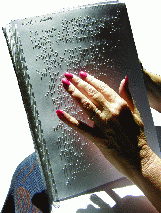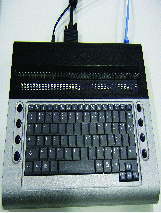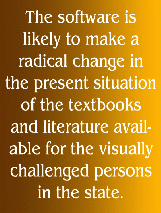Let the Blind Lead the Blind
Let the Blind Lead the Blind
 Literature and education for visually challenged persons in Assam is heading for a revolutionary change with the development of computerized transcription of Assamese language into Braille, using Duxbury systems - the world’s leading software for Braille that would automatically convert Assamese language written in Unicode - computer language into Braille.
Literature and education for visually challenged persons in Assam is heading for a revolutionary change with the development of computerized transcription of Assamese language into Braille, using Duxbury systems - the world’s leading software for Braille that would automatically convert Assamese language written in Unicode - computer language into Braille.
The software has been developed at the initiative of the North-eastern Regional office of the National Federation of the Blind (NFB), in collaboration with New Delhi based Saksham Trust and Daisy Forum of India, the non-profit organisation working in the field of production of books and reading material in accessible formats for persons who can not read normal print. “I am so excited! The software has already been developed successfully, tested, and I have received 20-pages of reading material for a test-reading, which shows 99 per cent accuracy in the software,” says Mohd. Imran Ali, Vice- President of NFB, who heads the North East regional office located at Guwahati. There is a minor problem with one or two letters, which is likely to be overcome soon, he says.
Ali, who himself is a visually challenged person and an official of the Steel Authority of India Limited, Guwahati office, says that the idea of developing the computerized Assamese transcription into Braille came to him when NFB, North East regional office organised a national level seminar on the theme of new avenues of visually challenged persons in the IT Sector in Guwahati, in March 2009.
“I met Dipendra Manocha, head of the Saksham Trust which works in collaboration with Daisy Forum of India, who presented a paper at the seminar. He has been relentlessly working towards providing print material to disabled persons in the country and abroad. I requested him to develop the software for the Assamese language. He took the matter seriously, and within a year has completed the work.”
The software is likely to make a radical change in the present situation of the textbooks and literature available  for the visually challenged persons in the state. The Braille Translation Software was originally used in tandem with different European languages. It has already been developed to transcript a number of major Indian languages including Hindi.
for the visually challenged persons in the state. The Braille Translation Software was originally used in tandem with different European languages. It has already been developed to transcript a number of major Indian languages including Hindi.
Dipedra Manusha tells Eastern Panorama that he has volunteered himself for integration of the Duxbury Systems which is the most commonly used software for the conversion of alphabets to Braille, for all Indian languages.
“The Hindi language was integrated to the software initially nearly 8 years back. Since then we have been working for the integration of other Indian languages to the Duxbury Systems,” he says.
The Assamese and Bengali languages have been integrated to the system in collaboration with the National Institute for Visually Handicapped (NIVH) Dehradun. He says that Saksham is interested in the integration of all major languages of the North East into the system.
Lack of the software in Assamese so far has compelled the NFB’s North East regional office that was established in 2007 to move for the installation of a Talking Book Library equipped with CDs to help Assamese medium students in its state-of the-art Digital and e-text Talking-Book Studio and Library for academic and professional concerns. He says that although reading material in the form of talking books, Braille books, or e-text books are easily available in the English language, these are very limited in Assamese. The NFB’s Guwahati office has already digitalized a number of talking books for Assamese medium students of Class IX, X, Higher Secondary, and various degree courses where they preserve these books in CD form.
“An extension of this process is a door - step delivery system of Braille books in the state, which is likely to begin shortly with the help of NIVH. It will act as a circulating library under which books and reading material will be provided through post to the students and candidates appearing for different competitive examinations and after completion of the study the student can return them accordingly,” he adds.
Meanwhile, to help visually challenged persons academically and professionally, the NFB has started a one year job oriented training course for the educated blind entitled ‘Computer Application and Office Management’. The course includes official writing and drafting of computer, spoken English, preparation for the competitive examinations apart from orientation and mobility of visually challenged persons in different situations.
 The first batch of 10 visually challenged persons coming from different parts of the state of which four are women have already completed the training. Of them, two graduates, Moromi Dutta will appear in Bank Recruitment examinations, while Tankeswar Hajarika will appear in the competitive examinations for Railway Assistant Manager. “The NFB will also help these trainees financially if they wish to set up their own business establishments at their own place,” says Ali.
The first batch of 10 visually challenged persons coming from different parts of the state of which four are women have already completed the training. Of them, two graduates, Moromi Dutta will appear in Bank Recruitment examinations, while Tankeswar Hajarika will appear in the competitive examinations for Railway Assistant Manager. “The NFB will also help these trainees financially if they wish to set up their own business establishments at their own place,” says Ali.
Training for the next group of 10 students, of which three are from Shillong has started on March 27, this year.
To promote higher education among the visually challenged persons in the North East, the NFB has initiated an elaborate programme of scholarships for college students. The scholarship amount is Rs. 500/ per month for Higher Secondary students, Rs. 1,000/ for graduate students and Rs. 1,500/ for Post Graduates and other disciplines. It has the provision of giving scholarships to 50 students in Assam and 30 students from other northeastern states each year.
Md. Ali however, is quite disheartened over the slow response of candidates towards availing these scholarships. “This is because of ignorance about our organization which explains why the number of applicants availing these scholarships is very limited. Apart from Assam, only 10 applicants had applied from Tripura last year. This year, however, nobody applied from that state,” he says.
Stating that NFB, which is a financially sound organization with the objective of ‘Let the Blind Lead the Blind’ with a membership strength of over 1,00,000 across the country, most of whom are well - established in different professional fields, has its own resource generation systems which includes insurance schemes, soft loans, donations and others.
He says that its financial assistance to a visually challenged person goes up to Rs.30,000. If NFB provides more than this amount then there is a rate of interest against the assistance.
Some of the programmes of NFB in the northeastern states includes establishment of a college hostel and a modern school for visually challenged students in Golaghat for which 5 bighas of land has been allocated and another in Guwahati for which another 4 kathas of land has been allotted; establishment of vocational training institute for visually challenged adults for which two rooms at the District Industrial Centre in Lakhimpur district have been allotted; to upgrade the system of education for visually challenged students at par with the national standard; and finally the installation of a computerized Braille press for printing of Braille books and supply of other educational equipment to schools for the blind of the region.
Ratna Bharali Talukdar


